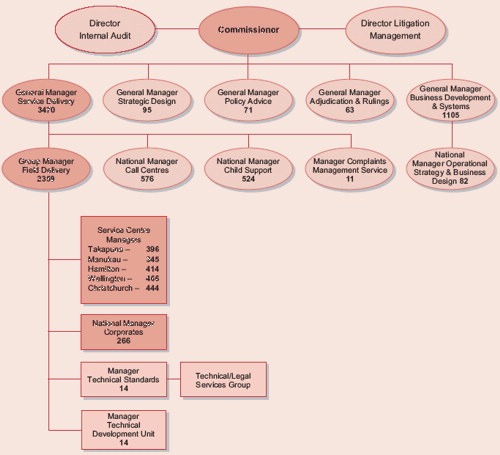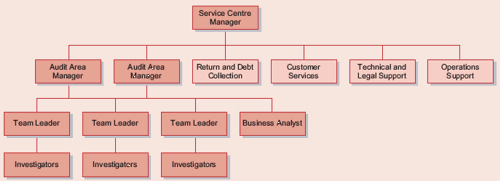Part 2: Background
- Duties and General Responsibilities of the IRD
- Structure, Roles, and Responsibilities
- What Does an Investigator Do?
- The Cost and Scale of Taxpayer Audit
Duties and General Responsibilities of the IRD
2.1
Section 6 of the Tax Administration Act 1994 imposes a responsibility on the Commissioner and all IRD staff “at all times to use their best endeavours to protect the integrity of the tax system”.
2.2
Section 6A of the Tax Administration Act sets out the Commissioner’s principal duties under revenue legislation:
- “care and management of the taxes covered by the Inland Revenue Acts”; and
- the duty to “collect over time the highest net revenue that is practicable within the law, having regard to the resources available to the commissioner, the importance of promoting compliance by all taxpayers, and the compliance costs incurred by taxpayers”.
2.3
In short, the Commissioner is not expected to assess and collect every dollar of tax due, come what may.
2.4
In 1999, the IRD began to prepare a standard practice statement that would clarify for IRD staff, taxpayers and tax practitioners some uncertainties in the wording of section 6A(3) relating to the IRD’s ability to reach agreements with taxpayers on a case-by-case or global basis. That year, the IRD issued a draft standard practice statement, but the draft was subsequently withdrawn, and some four years later there is a concern that the issue has still to be resolved.
2.5
Reaching agreement on a revised statement is a complex matter. The IRD has therefore decided to prepare internal guidelines for staff on how they should interpret section 6A(3), with a view to achieving consistency in how the section is applied.
2.6
In addition to collecting revenue on behalf of the Crown, the IRD is responsible for:
- providing policy advice to the Government;
- interpreting tax legislation;
- providing services to assist in collecting revenue; and
- the administration of some social policy schemes.
Structure, Roles, and Responsibilities
2.7
The IRD’s taxpayer audit forms a large part of the IRD’s business with some 853 staff involved in delivering audits (and approximately 28 staff in management, compliance risk analyst, and design roles related to audit) out of a total workforce of 4800 at February 2003. The delivery of taxpayer audit is one of a range of responsibilities of the General Manager – Service Delivery, who is the lead manager for most of the IRD’s staff. The management structure is shown in Figure 1 below.
Figure 1
IRD Senior Management Structure

2.8
A different general manager, the General Manager – Business Development and Systems, has among his responsibilities the Design and Monitoring Group (see Figure 1 on the previous page). This group establishes the overall design of activities undertaken in service centres, including taxpayer audit. The design includes output contracts, quality standards, measures, and systems. For example, the group designed the audit manuals and the Quality Measurement System, which we refer to in other parts of this report.
2.9
Service Delivery is made up of four functions, one of which is Field Delivery. It is through this management line that taxpayer audit staff (based either in the Corporates Division or one of the five service centres) report to the Group Manager – Field Delivery. This manager is also responsible for the customer service and return and debt collection work undertaken in the service centres and Corporates Division.
2.10
Figure 2 below illustrates the management structure of a typical service centre (the Corporates Division structure is shown in the Appendix on pages 83-84), showing the detail of the taxpayer audit element. The service centre managers are responsible for a range of key customer-facing activities, of which taxpayer audit is one. They and the audit staff have wide discretion for determining the way audits are done. To date, the Design and Monitoring Group has generally only used persuasion to get them to adopt new initiatives that the group designs.
Figure 2
Service Centre Management Structure

2.11
As outlined on page 20, the IRD has recently set up a Business Initiatives Governance Board. The Board has, as one of its objectives, to ensure that new initiatives are formally adopted and implemented.
2.12
Figure 3 below provides a simplified overview of the structure for taxpayer audit, including the position of the “Audit Portfolio Holder” role that we describe in paragraphs 2.14-2.15.
Figure 3
Overview of the Structure for Taxpayer Audit

2.13
As illustrated in Figures 1 to 3 and in the Appendix, the structure of taxpayer audit is complex, reflecting its size and importance to the IRD.
2.14
The Audit Portfolio Holder (see Figure 3) has a remit across the five service centres but has no direct responsibility for audit staff, except those in his own service centre. He is responsible for ensuring delivery of national targets and promoting best practice in taxpayer audit across the five service centres. This involves providing cohesion, consistency, and a co-ordinated approach to reporting on taxpayer audit performance, but the discretionary nature of many initiatives limits the effectiveness of the role.
2.15
In January 2003, the role of the Audit Portfolio Holder was strengthened in an attempt to clarify its relationship with service centre managers, audit area managers, and team leaders. The change was intended to help increase consistency and reduce the autonomy of the service centres in relation to taxpayer audit. However, it is too soon to tell how much effect this has had on the respective responsibilities of the service centre managers and the Audit Portfolio Holder.
What Does an Investigator Do?
2.16
IRD investigators have a challenging job. They have to deal with complex legislation and highly technical issues, and audits are undertaken in often stressful, and occasionally confrontational, circumstances.
2.17
Investigators are involved in selecting particular taxpayers to be audited and carry out the audits to identify any potential discrepancies. They are not involved in collecting the tax they have assessed as due – return and debt collection staff carry out this function.
2.18
As the length and complexity of taxpayer audits increase, the need also increases for investigators to have more skills, experience, and an in-depth understanding of tax laws and technical accounting issues.
2.19
Figure 4 on the next page outlines the three categories of taxpayer audits. Audits vary greatly in length, and not all audits involve visits to taxpayers. Investigators complete many of the short-term audits using information that the IRD holds about taxpayers.
Figure 4
Types of Taxpayer Audits
| Type of Audit | Tasks Undertaken |
|---|---|
| Short-term Audits – generally deal with one return period only and one tax type. They are of short duration, taking less than 20 hours. | Registration checks Non-filer checks Goods and Services Tax (GST) refund checks Income tax audits GST audits Payroll audits Voluntary disclosure checks |
| Medium-term (Extended) Audits – generally deal with more than one return period for one or more tax types. They are of medium duration, taking 20-50 hours. | Extended income tax audits Extended GST audits Multi-revenue audits Extended dual revenue audits |
| Long-term Audits (Investigations) – generally deal with more than one return period and all tax types. They are of relatively long duration and ordinarily take 50-500 hours. In the Corporates Division these can take well over 1000 hours. | GST investigations Full investigations Aggressive tax issues (tax avoidance) investigations Evasion investigations Criminal Fraud investigations audits |
The Cost and Scale of Taxpayer Audit
2.20
Taxpayer audit consumes 23% of the total cost of running the IRD and is the largest single activity undertaken.
2.21
For the year to June 2003, the planned cost of taxpayer audit (excluding Litigation Management) was $91 million excluding GST – representing $73 million for the audit work done in the service centres, and $18 million in the Corporates Division.4
2.22
With this funding the IRD intended to dedicate between 823,000 and 843,000 hours to conducting audits in the service centres, and to assess tax payable of at least $550 for every audit hour completed. In the Corporates Division, the IRD planned to dedicate between 191,000 and 201,000 hours to audits.5
2.23
When the IRD seeks additional funding for increased taxpayer audit activity, it demonstrates that additional tax revenue will be assessed as a result. Given that the IRD can demonstrate this fact, it is up to Parliament to decide how much additional funding it wants to give the IRD for taxpayer audit activity to secure additional revenue. The balance between the amount of funding given to the IRD and other government departments is necessarily a political decision.
2.24
Most taxpayer audit staff are based in the IRD’s five service centres. At February 2003, there were 615 investigators and 84 team leaders across all the service centre areas. All service centres except Manukau have at least one branch office – Christchurch with five has the most.
2.25
At February 2003 there were 154 investigators and senior investigators in the Corporates Division.
2.26
In addition, 28 staff are in management, design, and analyst roles related to taxpayer audit.
4: IRD Statement of Intent, 2002-03, parliamentary paper B.23 SOI (2002).
5: The length of audits conducted by the Corporates Division and the very large sums assessed mean that a measure of additional revenue gained per audit hour is of little value and no such target is set.
page top